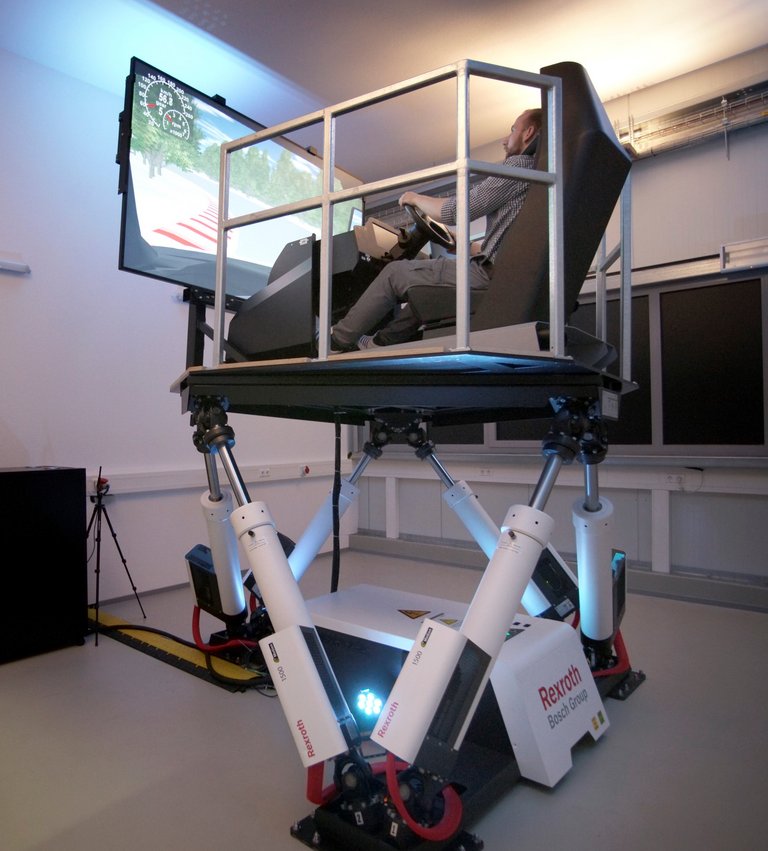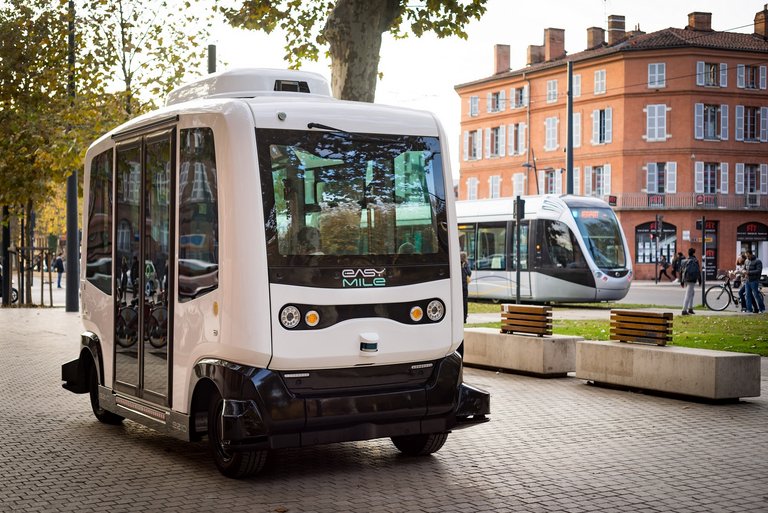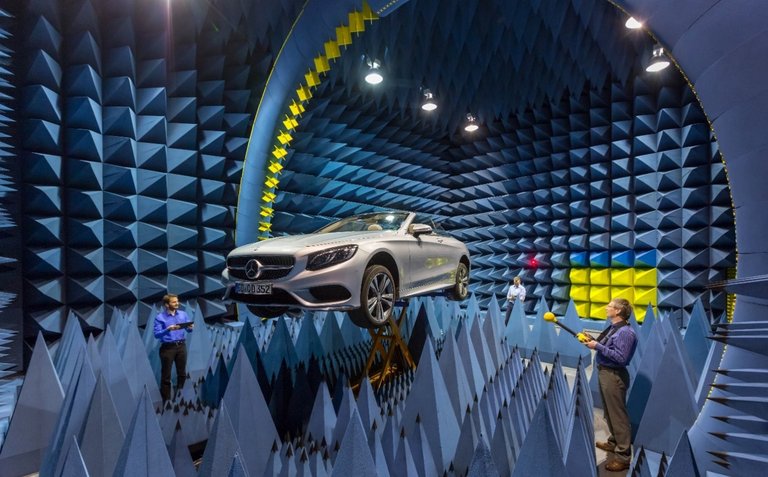Before the end of this year, the first automated minibuses will begin passenger service in the Goethe and university city of Ilmenau. The Thuringian Innovation Center for Mobility (ThIMo) at the TU Ilmenau is supporting the implementation of highly automated driving in public transportation as part of a family of research projects focusing on radio and vehicle technology as well as technology acceptance.
Automated minibuses in the "Living Lab
An aspect of mobility research at the Thüringer Innovationszentrum Mobilität

Driverless vehicles have been on the public's mind not just since Tesla's Autopilot. Back in the 1990s, German professor Ernst Dickmanns, who is now considered a pioneer in the field of autonomous vehicles, equipped the first "robot car" with cameras and sensors. These provided it with data about its surroundings and traffic, enabling it to travel its test route without a human driver. While driver assistance systems of automation levels 0 to 2 (according to SAE International) such as cruise control, parking assistance or lane departure warning already support many drivers on a daily basis, actual "self-driving" cars are still not a matter of course in everyday life. However, this may soon change with a new law on autonomous driving: Since July 2021, highly automated vehicles of automation level 4 may for the first time be put into regular operation in Germany in defined operating areas in local public transport without a safety driver.
International standard SAE J3016 distinguishes between six levels of automation: |
Potentials and research needs
The increased use of autonomous vehicles in local public transport and their networking with the transport infrastructure could reduce traffic density in inner cities in the future, resulting not only in reduced travel times but also in lower emissions. The population in rural areas could also benefit from more flexible route and travel time planning through the use of self-driving shuttles on the so-called "last mile." However, the great potential to make mobility of the future more flexible, efficient, safe, intelligent and sustainable is still accompanied by many unanswered questions. The technology of highly automated vehicles must prove itself in concrete deployment scenarios and complex situations before it can significantly improve our current traffic concept. How does the autonomous vehicle understand what is happening at a major intersection? How can a seamless radio network connection be ensured? Interdisciplinary project teams at ThIMo are addressing precisely these and other important questions - using simulation programs on the computer, on test benches in the laboratory and increasingly directly on the road in real traffic.
The "Automated Driving in Public Transport" Project Family: Campus Bus, KREATÖR and P:Mover
As part of the "Campus Bus Project", two electric buses from the manufacturer EasyMile of type EZ10 Generation 3, automated according to Stage 3, are expected to be used this summer in the regular service of IOV Ilmenau between the train station of the city of Ilmenau and the campus of the TU Ilmenau. For licensing reasons, these will initially still be accompanied by a safety driver. The two regular service vehicles will be equipped with additional sensor technology for research purposes. In addition, a third research vehicle will be made available to ThIMo scientists. The campus bus project is funded by the Thuringian Ministry for the Environment, Energy and Nature Conservation and managed by the Ilm-Kreis district and its own company, Ilm-Kreis Personenverkehrsgesellschaft mbH (IKPV).

In the project "KREATÖR - Radio and Vehicle Technologies for Automated Passenger Transport in Public Spaces", this new transport service of the city of Ilmenau and the Ilm district is scientifically accompanied in the sense of a real laboratory by the ThIMo with funding from the Thuringian Ministry of Economics, Science and Digital Society. Selected test routes become a real lab or "living lab", as research into new mobility concepts does not only take place on the computer or in the laboratory, but also in real traffic, embedded in a social context. Four groups of the inter-departmental Institute for Mobility Research are dedicated to researching and developing innovative radio and vehicle technologies in this project. A fifth department is concerned with the risk perception and acceptance of the technology among passengers and the media public. Although highly automated minibuses have already been deployed at other locations in Germany and other European countries (including Gera, Bad Birnbach, Hamburg), this high-level interdisciplinary accompanying research and further development in Ilmenau is an important distinguishing feature.
In the recently launched project "P:Mover - Pioneer Region: Connecting Mobility Solutions in Suburban Areas", which is funded as part of the 5G Innovation Competition of the German Federal Ministry of Digital Affairs and Transport, the use after Stage 4 of automated buses is to be prepared on further routes in the Ilmenau pioneer region. Here, the safety driver will be replaced by a control center via radio link. The focus of this project is the establishment or expansion of the 5G mobile network in order to explore the specific potentials of digitalization, automation and networking for the transport sector. In this context, the city of Ilmenau and the ThIMo are supported by Funkwerk Systems GmbH and Ginger Lehmann + Partner GmbH. Individually and in combination, all three projects represent important steps in the development of intelligent, sustainable and user-oriented transport in the Ilm district.
Several research projects of the ThIMo involving other Thuringian actors in mobility and logistics research build on these projects. They not only form core elements of a potential location cluster for the mobility of the future, but also promote a bouquet of measures to support the transformation of Thuringia's automotive and supplier industry.
Drive optimization and digital twin
In order for autonomous shuttle buses to be optimally integrated into the traffic flow and achieve maximum range per battery charge, they need drives that are as well adapted as possible to the routes on which they will be used. The goal of the small machines department involved is therefore to map, evaluate and optimize the existing drive in a precise model in order to achieve an optimum compromise between the requirements of the route, the dynamics required from a safety point of view and the design of the drive. In this context, the department also addresses the question of the extent to which differently designed specialized drives offer an advantage over a variant that is dimensioned for a universal and wide range of applications. For this purpose, the scientists have access to a separate motor of the same design with control electronics for their research purposes. This motor will be commissioned in the laboratory test stand, measured and modeled in a simulation program. Once the buses have been delivered, their driving profile is recorded using the high-precision measurement technology of the Vehicle Technology department. With the aid of satellite navigation data, the route is measured and digitally simulated, including gradients, slopes and speeds. Based on this driving profile, a simulation of engine performance will be carried out. The aim is to identify the parameters that have the greatest influence on drive performance. The results of this simulation are then compared with measurements on the real engine in the test rig. In this way, the drive can ultimately be optimally designed with regard to the scaled performance requirements.
The Group of Automotive Engineering itself is using the recorded driving profile to model a complete "digital twin" of the EasyMile EZ10 in a powerful simulation environment. Instead of working with an additional engine, the research team will equip the provided research vehicle with measurement components to mirror it on a dynamic driving simulator. In this way, the scientists will be able to collect data on driving dynamics (e.g., movements of the vehicle during braking and acceleration as well as changes in driving direction) in order to assess driving safety and comfort and determine relevant influencing variables.
From automated to intelligently connected driving
In order for autonomous minibuses to be able to handle all driving tasks autonomously, they must record their dynamically changing environment with cameras, radar and lidar sensors in order to observe their own movement characteristics as well as those of other road users in real time and translate them into safe driving functions. At present, this measurement technology cannot fully replace human cognitive abilities to grasp a complex traffic situation. However, if vehicles are networked with other road users and the traffic infrastructure by means of wireless technologies (vehicle-to-everything or V2X communication), safety-relevant information can be exchanged at an early stage, e.g., on unexpected hazards with accident potential. This not only increases safety, but also optimizes traffic flow and minimizes particle, noise and field strength emissions.

To test such solutions and guarantee their functional safety, networked vehicles would actually have to drive billions of test kilometers before being approved. Since this would require immeasurable resources, approval procedures have switched to scenario-based testing in virtual environments. The ThIMo Groups RF and Microwave Research and Electronic Measurements and Signal Processing are researching virtualizing such test drives and recreating them in the lab. Here, too, the digital twin is used. For example, additionally installed radar sensors are used to record sensor data from the buses during the runs and map it in a special virtual measurement environment. The Virtual Road Simulation and Test Facility (VISTA), which is unique in Europe, is equipped with an antenna system and comprehensive measurement technology for the virtual verification and validation of automotive radars. The research infrastructure is currently being expanded with a measurement facility to extend the antenna measurement capability into the THz range (mobile phone generation 6G) and for recording bi-static radar cross sections of mobile objects. Bistatic radar describes the increasingly important case in traffic where a traffic object is illuminated and observed from different directions. Understanding this object-specific angle-dependent wave propagation is one of the basic prerequisites for developing autonomous driving into cooperative driving in intelligently networked safe traffic.
Such a networked mobility concept requires the joint development of traffic, data and network infrastructures. To ensure that the safety driver no longer has to be on board, but can be connected to the vehicle via radio from a control center and in this way, in principle, even supervise several vehicles at the same time, the P:Mover project will use the latest mobile communications capabilities by setting up 5G-capable base stations at suitable locations along the traffic area. In particular, these ensure higher bandwidths, lower latencies and overall higher reliability than their 4G predecessors.
Public perception and acceptance
Since technological developments are always embedded in a social context, only the involvement of the public can provide information on how well autonomous shuttle services meet actual needs and meet with acceptance. Both are crucial for demanded use and the associated sustainable changes in the transportation sector. However, there has not yet been a broad social debate, for example on ethical issues. In order to counteract this and to involve the population of Ilmenau, the Department of Public Relations and Technology Communication is accompanying the pilot operation of the automated minibuses with communication science analyses of risk perception, acceptance and willingness to use in the population. Quantitative surveys conducted before and after the introduction of the shuttles are a central research tool for comparing expectations, fears and attitudes. Media content analyses are also used to examine thematic focal points and evaluations in reporting, as this has an opinion-forming influence on public perception. The research results can, for example, produce important findings in the area of experienced driving comfort for the engineering disciplines. However, they also provide information about the areas in which educational work is still necessary so that the population can realistically assess the risks and opportunities of autonomous driving. In this way, a social discourse can also be conducted regionally in order to help shape the mobility of the future.
The interdisciplinary scientific expertise and modern research infrastructure of the ThIMo, as well as the environment of a living lab in the pioneering region of Ilmenau, provide the best conditions for such a user-centered approach and hold great potential for innovation.
Further information at: http://www.mobilitaet-thueringen.de/
Contact
Prof. Dr. Matthias Hein
Director Thüringer Innovationszentrum Mobilität

